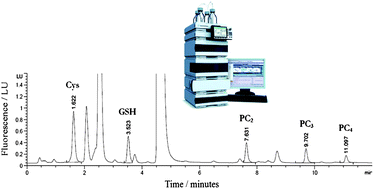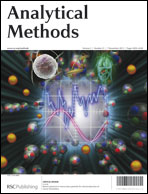Separation and quantification of cysteine, glutathione and phytochelatins in rice (Oryza sativa L.) upon cadmium exposure using reverse phase ultra performance liquid chromatography (RP-UPLC) with fluorescence detection†
Abstract
Thiol compounds in plants, such as cysteine (Cys), glutathione (GSH) and phytochelatins (PCs), may be induced upon exposure to excessive potentially toxic metals and metalloids. In this paper, Cys, GSH, PC2, PC3 and PC4 in rice leaf, stem and root samples were derived with monobromobimane (mBBr), separated by reverse phase-ultra performance liquid chromatography (RP-UPLC) and detected by fluorescence. The results showed that, after reduction with tris(β-chloroethyl)phosphate (TCEP), the above thiols were rapidly separated with binary gradient elution in 15 min. The calibration curve was linear in a range of 1–20 μg mL−1. The limit of detection (LOD) for thiols was 0.14 pmol for 1 μL injection (0.10 μg g−1 F.W), and the recovery was 91.55% on average. Compared with the previously reported methods, the technique developed in this work demonstrated higher speed and sensitivity in the simultaneous measurements of Cys, GSH and PCs in rice. Upon exposure of 1 μM Cd for 7 days, the PC2–4 were remarkably induced in rice roots, whereas the amounts of Cys and GSH, the dominant thiol compounds in rice leaves and stems, were reduced.


 Please wait while we load your content...
Please wait while we load your content...